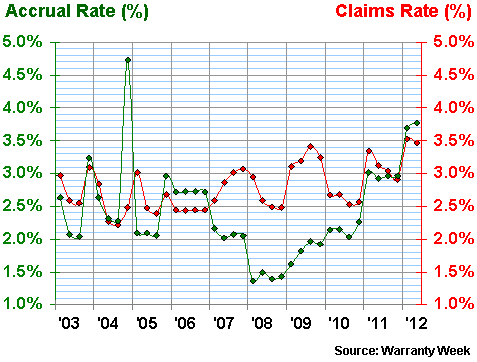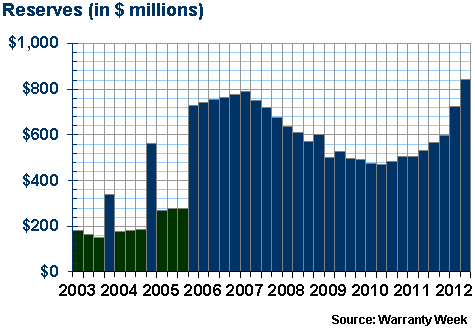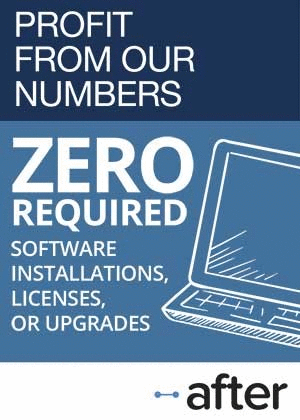Navistar's Warranty Woes:
Its older engines don't meet EPA standards and need more warranty work than expected. Profits have vanished as costs have risen. Competitors are winning both the technology battle and the court fights. And a hostile takeover attempt may be imminent.
The vultures are circling above Navistar International Corp., as engine trouble causes the company to report rising warranty costs and net losses.
The primary cause is the problem the company is having with the diesel truck engines it sells, which are experiencing elevated warranty costs. A secondary cause is the problem the company is having with the engines that it can't yet sell, because regulators have not yet certified them to be compliant with recent anti-pollution emission standards.
It's nearly the middle of 2012 and Navistar still doesn't have an engine for sale that's compliant with 2010 anti-pollution standards. Recently, Navistar and the U.S. Environmental Protection Agency found a way to work around the lack of a certified diesel engine by imposing "penalties" that were "paid" with emission credits amassed from the sale of other products. But that system is now likely finished -- killed off by a jealous competitor's lawsuit.
Since the beginning of this year, every time Navistar sold an old and dirty diesel engine, it used up some of the credits it earned from the EPA during the years 2007 to 2009, when some of its products exceeded the EPA anti-pollution standards then in effect. But when those credits run out sometime this year, Navistar is probably going to have to use real cash to pay the EPA a fine of as much as $1,919 per engine sold.
Losing in Court
However, competitors recently won a round in court under which this temporary fine-in-lieu-of-compliance arrangement was ruled illegal. So unless the EPA comes up with a viable alternative to the fines, Navistar may have to completely stop selling engines that don't meet the EPA's 2010 anti-pollution standards.
Adding to the company's pain, those old and dirty engines are also proving to be less reliable than the company initially believed them to be. In the first quarter, Navistar had to make an additional warranty accrual of $123 million above and beyond its usual $111 million set-aside. In the second quarter, it had to add another $104 million special accrual on top of its regular quarterly $125 million accrual. That means the company has set aside almost as much in the first six months of this fiscal year as it did during the whole of last year.
It's now gotten to the point where elevated warranty costs are impacting profitability. On June 7, Navistar reported a loss of $172 million, or $2.50 per share, for the second quarter ended April 30, 2012. That bad news came after a reported loss of $153 million, or $2.19 per diluted share, reported for the company's first quarter ended January 31, 2012. And it caused Navistar's share price to hit a three-year low of $20.21 on heavy volume that day.
Preparing for Battle
Later on June 7, after Navistar's share price dove, investor Carl Icahn announced he had boosted his stake in the company to 11.87%, up from 9.99%. At the same time, MHR Fund Management LLC, an investment firm led by Dr. Mark H. Rachesky, upped its stake in Navistar to 13.6%.
On June 20, Navistar announced what it called a "Stockholder Rights Plan," which the company said "is designed to deter coercive takeover tactics including the accumulation of shares in the open market or through private transactions." It does this by creating a new series of preferred shares which will only come into being if somebody attempts to buy 15% or more of the company's common shares.
Navistar did not announce who this "poison pill defense" might have been directed towards. However, besides Icahn and Rachesky, there are no other investors anywhere near 15%. After them, the largest investments in Navistar are held by Franklin Resources Inc. (7.47%) and Wellington Management Co. LLP (6.71%).
Anti-Pollution Standards
It all started in California. The state, famous for its smog, is also famous for its abundant regulations. So it's no surprise to find that it's a leader in anti-smog regulations. And since nitrogen oxides are a famous cause of smog, and since diesel vehicles and diesel equipment are famous causes of nitrogen oxide emissions, it's no wonder that the state paved the way towards regulating diesel engine emissions.
In 2002, California's Air Resources Board, part of the California Environmental Protection Agency, implemented a "Verification Procedure, Warranty and In-Use Compliance Requirements for In-Use Strategies to Control Emissions from Diesel Engines," which sought to reduce the emissions of particulate matter and oxides of nitrogen (NOx) by diesel-fueled engines.
The regulations didn't specify how, but they did set goals for how much. Therefore, truck engine manufacturers each began developing their own emissions-reducing technologies. We'll detail some of those technologies in a second, but the key point is that Navistar chose something and virtually all its competitors chose something else. And now they're all compliant and Navistar isn't.
Reducing Emissions Levels
Every few years, the EPA has reduced the maximum amount of allowed emissions. From 1998 until 2004, the EPA standard for oxides of nitrogen was 4 grams of emissions per brake-horsepower-hour and the EPA's hydrocarbon standard was 1.3 g/bhp-hr. After 2004, the combined standard for oxides of nitrogen and hydrocarbons was reduced to 2.4 g/bhp-hr. Then they were reduced again in 2007, and again in 2010.
As of the 2010 model year, the maximum level allowed by the EPA is 0.20 g/bhp-hr for oxides of nitrogen -- an astonishing 95% reduction since 2004. Even more astonishing is the way that many manufacturers were able to meet the tougher standard, by essentially turning air pollution into humid air.
However, as of the 2012 model year, manufacturers that do not meet this new and tougher standard must pay a monetary non-conformance penalty per engine sold, which rises proportionately according to how far above the EPA '10 standard the engine is rated. The fine is about $950 for an engine that emits 0.35 grams of NOx or more, and it tops out at about $1,919 per engine for emissions of 0.50 grams or more.
On the flip side, the EPA also allowed manufacturers to "bank" credits they may have accumulated for exceeding the cleanliness standards for other products, and to "spend" those credits on the fines in lieu of paying actual money. Navistar, for instance, accumulated enough credits a few years ago to offset the penalties it would have begun paying at the start of this year. Its latest engines are down to 0.39 g/bhp-hr, but that's not good enough for EPA '10.
Statutory Emissions Warranties
By the way, besides enforcing maximums on emissions, these anti-pollution laws also typically set minimum durations for product warranties. For instance, Section 2707 of CARB's diesel engine regulations specifies minimum warranty durations for different types of engines. The regulations cover both manufacturers and installers, and both parts and labor. Over some four pages of text, they also spell out much of the language to be included in the warranty's terms and conditions.
In general, on-road engines got longer minimum warranties than off-road or portable models, though most of the warranties also could expire on usage (mileage or hours). Only the largest on-highway truck engines feature warranties with unlimited mileage, though they are also the shortest on time (most are for three to five years, but the unlimited mileage warranties expire after two).
Figure 1
California Air Resources Board
Minimum Warranty Periods for Diesel Engines
Source: California Code of Regulations, Title 13, Division 3, Chapter 14, § 2707
Click on the table above to see a larger version.
Meanwhile, the latest EPA regulations specify minimum warranty durations of five years or 100,000 miles for heavy-duty on-road diesel engines; five years or 50,000 miles for gasoline engines; two years for small off-road engines rated at 25 horsepower or less; and five years or 3,000 hours for off-road engines rated over 50 horsepower. Boat engines made after 2004 are required to carry warranties of two years or 200 hours for all emission control components and three years or 200 hours for specified major emission control components.
And of course the regulations also specify the maximum amount of emissions allowed per unit of time and per unit of power. But they didn't specify how the engine manufacturers were going to meet the lower emission levels. Instead, they left that up to the market to come up with the most innovative solutions. But of course, no government agency is going to mandate 95% reductions in six years unless they believe the technology exists to do so.
Choosing Technologies
The technology that almost everyone chose is called Selective Catalytic Reduction, or SCR. Except for Navistar, most truck engine manufacturers backed SCR as their anti-pollution technology of choice, even though it required the creation of yet another type of automotive fluid to join fuel, coolant, lubricant, and others.
- Cummins Inc. uses Selective Catalytic Reduction, as well as a Diesel Particulate Filter and something it calls the Cummins Emission Solutions EcoFit Ultra-Low Emissions exhaust aftertreatment system.
- Detroit Diesel Corp., part of Daimler AG, also uses Selective Catalytic Reduction and a Diesel Particulate Filter, in addition to Exhaust Gas Recirculation and a Diesel Oxidation Catalyst.
- Paccar Inc., makers of the Peterbilt, Kenworth, DAF and Leyland Trucks nameplates, also uses Selective Catalytic Reduction and a Diesel Particulate Filter, in addition to Controlled Exhaust Gas Recirculation.
- Volvo Trucks, which also owns Mack Trucks and Renault Trucks, also uses Selective Catalytic Reduction and a Diesel Particulate Filter, but in its latest engines it shuns active regeneration. That technology, featured in older engines, used additional diesel fuel to incinerate soot, which cut into fuel efficiency.
According to the Diesel Technology Forum, Selective Catalytic Reduction is an advanced emissions control technology system that injects a liquid-reductant agent, typically automotive-grade urea, through a special catalyst into the exhaust stream of a diesel engine.
This sets off a chemical reaction that converts nitrogen oxides into nitrogen, water and carbon dioxide, which is then expelled through the vehicle tailpipe. Essentially, SCR reduces smog-causing diesel engine emissions by turning them into humid air.
The group reports that SCR technology can achieve NOx reductions up to 90%, while simultaneously reducing hydrocarbon and carbon monoxide emissions by 50% to 90%, and particulate matter emissions by 30% to 50%. SCR systems can also be combined with a Diesel Particulate Filter to achieve even greater emission reductions for particulate matter (which us humans call black soot).
Another Tank to Fill?
However, SCR also requires an onboard tank filled with Diesel Exhaust Fluid, which must be replenished periodically, just like diesel fuel. For diesel-burning passenger cars, a tank of DEF might last for 3,000 miles -- about the same amount of time between oil changes. For trucks, fill-ups might need to be more frequent. And in cold climates, the DEF tank needs to be heated, since the fluid would otherwise freeze solid at 12° F.
As DEF becomes a necessary part of a diesel engine's lifecycle, it is increasingly becoming available for sale at locations such as truck stops, truck dealerships and engine distributors. For instance, according to a "Discover DEF" website aimed at diesel truck and bus operators, in the Dallas/Fort Worth area there are 16 outlets selling everything from jugs and drums of DEF to pumps that dispense it by the gallon. Even in Cheyenne, Wyoming, there are two truck dealers that stock DEF. And since it's neither flammable nor very toxic (urea is an ingredient in both skin creams and fertilizer), it can be moved around, stockpiled or traded in a rather easygoing manner.
To comply with the EPA's latest 2010 diesel engine emission requirements, Navistar is betting on a technology it calls Advanced Exhaust Gas Recirculation. EGR technology helped Navistar get its engine emissions down to 1.2 g/bhp-hr by 2009; to 0.50 g/bhp-hr by 2010; and to 0.39 g/bhp-hr by 2011.
Avoiding Urea Emissions
Basically, Exhaust Gas Recirculation does what its name implies: it sends the exhaust back into the engine to be burned a second time. But EGR is probably more notable for what it doesn't do. It doesn't depend upon urea, or the new DEF distribution network growing up around the new automotive fluid. And it doesn't depend on the customer having to find a DEF dispenser when their DEF tank runs dry.
"We have chosen EGR, combined with other technologies, as our solution to meet the 2010 emissions standards," Navistar stated in its latest annual report. "We believe coupling EGR with other emissions strategies gives our products advantages over our competitors' liquid-based urea SCR solution and enables us to maintain flexibility in meeting emission requirements. Our 2010 emissions strategy places the burden and responsibility of meeting the 2010 emissions standards on the company versus our competitors' liquid-based urea SCR solution that places that burden on the customer. We believe that our customer-friendly solution provides our products with a significant competitive advantage in North America, because most truck and engine manufacturers have chosen liquid-based urea SCR as the solution to meet 2010 emission standards."
The problem is, the EPA still hasn't certified a Navistar engine at 0.20 g/bhp-hr, and the credits are running out. So according to current "interim" EPA rules, Navistar will have to begin paying the penalties for noncompliance. The alternative would be to cease sales of noncompliant engines, which is something the EPA has tried to prevent from happening.
Mack Trucks v EPA
However, in a court case called Mack Trucks, Inc. v Environmental Protection Agency, competitors who made the big investments in SCR years ago and achieved 0.20 g/bhp-hr by 2010 are challenging the whole interim "pay the fine" regimen. And in its latest action, the U.S. Court of Appeals, D.C. Circuit, struck down the EPA's interim rule.
The EPA told the court it created the penalty rule as an interim solution to give Navistar time to achieve compliance. Mack said this interim rule essentially authorizes an illegal transaction: the sale of a noncompliant engine. Navistar, meanwhile, told the court that Mack lacked the standing to challenge the EPA's rule in the first place.
We're not lawyers, so forgive us if we oversimplify the lengthy and eloquent arguments of all the attorneys who fought this battle. But the problem boils down to this: everyone else used SCR and DEF, and everyone else is compliant. Navistar used EGR and is still not compliant. The EPA created new rules to help Navistar. The court struck down those rules.
However, that doesn't automatically mean that Navistar will have to stop selling its noncompliant engines when its credits run out. The court said the EPA is free to turn its "interim" rule into a final rule, as long as it follows its own guidelines for providing notice and a comment period, and as long as it can show "good cause" for promoting a rule that benefits just one company and protects it from the consequences of picking the wrong horse.
Rising Warranty Costs
But here's the bigger problem: the noncompliant engines Navistar is selling are beginning to generate a higher-than-normal level of warranty expense. So even if the EPA does eventually certify an EGR engine at 0.20 g/bhp-hr, the money Navistar saves by not paying fines may be spent on paying warranty claims. Will it turn out to be more or less than $1,919 per engine? Only time will tell.
It's only beginning to show up in the warranty data now. In the charts below, we've tracked Navistar's key warranty metrics from 2003 until the middle of 2012. This covers not only the period before and after the EPA '04 transition, but also the EPA '07 and now the EPA '10 transitions.
In the first chart, we've tracked the company's claims and accrual rates, calculated by dividing claims paid and accruals made by manufactured product sales revenue. But this has its drawbacks. First, the warranty data is a blend of Navistar's engine and vehicle sales, so it attenuates the impact of just the engine problems. Second, Navistar has so far been preparing for the expected rise in claims by adding additional accruals above and beyond the normal accruals. And this chart measures just those ordinary accruals.
Figure 2
Navistar International Corp.
Claims & Accrual Rates, 2003-2012
(as a % of manufactured product revenue)

Still, there are some items worth noticing. While the ordinary accrual rate soared to 4.7% at the end of 2004 (as the company dealt with warranty costs related to EPA '04 emissions-compliant engines), the ordinary claims rate has never been higher than it is now. Or at least it's never been as high as it was recently. Those with sharp eyes will see that the company's claims rate was slightly above 3.5% in the first quarter and was slightly below 3.5% in the second quarter. So technically, claims rates are now declining from their first quarter peak, which broke a record set in 2009.
And while the ordinary accrual rate was much lower in 2007-2009, that was caused primarily by the company choosing to cease making accruals for diesel engines sold to Ford Motor Co. while a warranty cost sharing dispute proceeded through the courts. So while it looks like Navistar's accrual rates have been rising dramatically for five years straight, that observation doesn't tell the whole story.
Yes, accrual rates have been rising for five years, but the first three years of that period represented a return to normal after the conclusion of the Ford lawsuit. And while things were back to normal in 2011, accrual rates in 2012 have been above normal. But they'd be higher still if they reflected the extraordinary accruals that Navistar has recently made.
Unanticipated Warranty Costs
Navistar made its usual accruals of $111 million for the fiscal quarter ending on January 31, 2012, which gave it a 3.7% accrual rate based on just over $3 billion in manufactured product sales. But it also made what it called "adjustments to pre-existing warranties" that amounted to $123 million, for unanticipated warranty expenses it said arose from sales of 2007 inline and initial-built 2010 engines. "Such adjustments typically occur when claims experience deviates from historic and expected trends," the company said in its quarterly financial statement.
"We proactively addressed these product issues in a low usage period during the first quarter, which we believe will improve long-term customer satisfaction and reduce warranty costs," stated Navistar chairman and CEO Daniel C. Ustian in an accompanying press release. "Strategically, we achieved a number of key milestones in the first quarter, including our submission of a 0.2 NOx engine for EPA certification and the announcement of our development of a full range of natural gas truck offerings."
But all was not back to normal when the company announced results for the following quarter. Ordinary accruals rose to $125 million, but a second upward adjustments to pre-existing warranties of $104 million was also required. That brought the tab for unexpected accruals to $227 for the first half of the company's fiscal year -- almost as much as its $236 million in ordinary accruals.
"Certainly, our first half performance was unacceptable. It included a warranty reserve to repair early 2010 and 2011 vehicles," the chairman said in the latest press release. "We were also affected by speculation surrounding our engine certification for our Class 8 engine, which is why we are working tirelessly with the U.S. EPA to get resolution."
Since the end of its last completed fiscal year in October 2011, Navistar has now set aside $463 million in ordinary and extraordinary warranty accruals. That's almost as much as the $486 million it set aside during all of last year ($407 in ordinary and $79 million in extraordinary accruals).
Rising Warranty Reserve Balance
Where is the money going? As can be seen by the only-slight recent upturn in claims rates in the chart above, most of it hasn't been spent yet. Instead, it's still sitting in the company's warranty reserve fund, which as the chart below illustrates, hit a record high balance of $844 million at the end of April 2012.
Figure 2
Navistar International Corp.
Warranty Reserve Fund Balance, 2003-2012
(at the end of each quarter)

We should note that the uneven pattern seen in the 2003-2005 balance has to do with an accounting restatement the company made of its warranty expenses during the period. In April 2006, Navistar fired its auditors and began to re-examine its warranty expense reports from 2002 onwards. Eventually, it restated the fiscal year-ending balances in its reserve fund -- but not the interim quarterly balances.
This leaves us with nine quarterly balances that we know are too low, but we don't know by how much. So we've drawn those nine balances in a slightly different color. And we advise readers to note that they're the product of a now-repudiated accounting methodology.
However, even if we dismiss those nine and look at just the intervening year-ending balances, the trend is clear: Navistar's warranty reserves declined until mid-2010, but have risen ever since. They've risen quite dramatically in the first half of fiscal 2012. And they've never been higher -- not even during the EPA '07 transition.
What Happens Next?
So what happens next? Hopefully, the EPA will certify a Navistar engine at the 0.20 g/bhp-hr level, so the company won't have to either (best case) pay fines or (worst case) cease engine sales. And hopefully, the latest design won't bring forward the flaws causing all the elevated warranty costs in the preceding generations.
Navistar is no stranger to the effects of litigation upon warranty costs. And it's also a veteran of the struggles to deliver EPA-compliant designs while controlling warranty costs. But now it's getting dangerous as costs rise and profits fall.
Navistar's problematic choice of anti-pollution technologies combined with some deft litigation by its competitors may soon force the company out of the engine business, at least temporarily. Elevated warranty costs may continue for at least the short term. And the hostile takeover vultures are beginning to circle.









